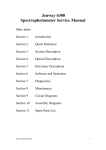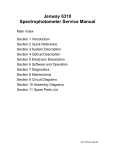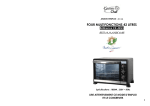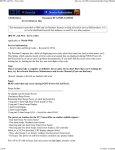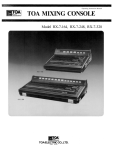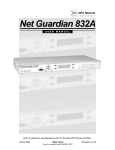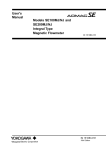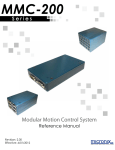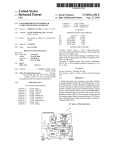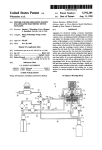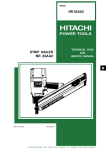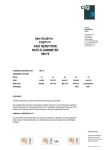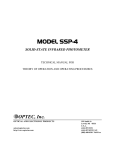Download Jenway 6500/05
Transcript
Jenway 6400/05 Spectrophotometer Service Manual Section 1 Introduction Section 2 Quick Reference Section 3 System Description Section 4 Optical Description Section 5 Electronic Description Section 6 Software Description Section 7 Diagnostics Section 8 Maintenance Section 9 Circuit Diagrams Section 10 Assembly Diagrams Section 11 Spare Parts List Jenway 6400-05 Ser Man Page 1 of 96 Section 1 Introduction 1.0 Index to Sections 1.1 About This Manual 1.2 Using This Manual 1.3 Warnings & Safe Practice 1.4 Standards & Certification 1.5 Ordering Spares 1.6 Returning Items 1.7 Contacting Jenway Limited Jenway 6400-05 Ser Man Page 2 of 96 Introduction. 1.0 Index to Sections Section 1 – Introduction 1.0 1.1 1.2 1.3 1.4 1.5 1.6 1.7 Index to Sections About This Manual Using This Manual Warnings & Safe Practice Standards & Certification Ordering Spares Returning Items Contacting Jenway Limited Section 2 - Quick Reference 2.0 2.1 2.2 2.3 2.4 2.5 2.6 2.7 About ‘Quick Reference’ Specification Main Sub-Assemblies Power Supply Voltages Signal Levels Error Codes Special Key Functions Test Solutions Section 3 - System Description 3.1 3.2 3.3 3.4 6400 & 6405 Comparison Sub-Assemblies Accessories Outputs Section 4 - Optical Description 4.1 4.2 4.3 4.4 Light sources Stray Light Filters Grating Signal Detector Jenway 6400-05 Ser Man Page 3 of 96 Section 5 - Electronic Description 5.1 5.2 5.3 5.4 5.5 Power Supplies Deuterium Lamp Supplies Detector Circuit Microprocessor and Memory Functions Accessory driver PCB Section 6 - Software Description 6.0 6.1 6.2 6.3 Warning Start Up Routine Main Menu Menu Options Section 7 – Diagnostics 7.1 7.2 7.3 7.4 7.5 7.6 7.7 7.8 7.9 The Diagnostics Menu Shutter and Filters Lamp Control Zero Order Cal. Calibrate Functions Wavelength Functions Channel Outputs Voltage Display Motor Position sensor Section 8 – Maintenance 8.1 8.2 8.3 8.4 8.5 8.6 8.7 Routine Maintenance Dismantling Energy Levels Wavelength Calibration A to D Calibration D to A Calibration Performance Verification Jenway 6400-05 Ser Man Page 4 of 96 Section 9 - Circuit Diagrams 9.10 9.11 9.20 9.21 9.30 9.31 9.32 9.33 9.40 9.41 9.50 9.51 Power Supply Schematic 640 008 Power Supply Layout 640 008 Deuterium Lamp Supply Schematic 640 506 Deuterium Lamp Supply Layout 640 506 Detector PCB Schematic 640 009 Detector PCB Layout 640 009 Detector PCB Schematic 640 505 Detector PCB Layout 640 505 Microprocessor PCB Schematic 640 007 Microprocessor PCB Layout 640 007 Accessory Driver PCB Schematic 642 003 Accessory Driver PCB Layout 642 003 Section 10 - Assembly Diagrams 10.1 10.2 10.3 10.4 10.5 10.6 10.7 10.8 10.9 6400 Final Assembly 640 003 6405 Final Assembly 640 503 6400 Lower Case Assembly 640 505 6405 Lower Case Assembly 640 505 6400/05 Top Case Assembly 640 005 6400 Optics Assembly 640 017 6405 Optics Assembly 640 517 6400/05 Rear Panel Assembly 640 006 6400/05 Multi-cell Chamger Assembly 644 002 Section 11 – Spare Parts List 11.01 11.02 11.03 11.04 11.05 11.06 11.07 11.08 11.09 11.10 11.11 11.12 Packed Instrument Top Case Assembly Microprocessor PCB Lower Case Assembly Lamp Housing Assembly Monochromator Assembly Detector PCB Power Supply PCB Deuterium Lamp Supply PCB Rear Panel Assembly Multi-Cell Changer PCB Built-In Printer Option Jenway 6400-05 Ser Man Page 5 of 96 1.1 About This Manual This manual covers the service, maintenance, calibration and repair of the Jenway Ltd models 6400 and 6405 Spectrophotometers. Throughout this manual all general statements and procedures should be considered to be relevant for both models. Where a statement or procedure is relevant to only one of the two models it will be clearly stated in underlined italics, to which model it relates, at the beginning of the relevant paragraph or section. This manual must be used in conjunction with the Instruction Manual for these models, as many of the routine maintenance procedures detailed in the Instruction Manual are not repeated in this Service Manual. 1.2 Using This Manual This manual is only for the use of Engineers and Technicians who have successfully completed a Jenway Ltd approved Service Training course on the 6400 and 6405 Spectrophotometers. Updates to this manual will be circulated through the Jenway Ltd TSI (Technical Service Information) systems and to other registered users of this manual. Please complete the form at the rear of this manual to register your copy for future updates. In practice Section 2 - Quick Reference and Section 8 – Maintenance, with the Diagrams in Section 9 and 10, will be most frequently used, however it is good practice to read the complete manual initially and review it again periodically. To find the information required refer to the Main Index or Index to Sections to identify the relevant Section/page number required. Jenway 6400-05 Ser Man Page 6 of 96 1.3 Warnings & Safe Practice Disconnect the mains supply when any covers are removed as there are high voltages present inside the unit that pose the risk of electric shock at levels that are hazardous to life! Do not look directly at the light sources or allow the light beam to fall directly on the eyes, switch off or dim the lamps (as described in the procedures) whenever possible and wear UV eye protection at ALL times. Both the UV and visible lamps get very hot when in use, always allow time for them to cool down before removing them. Always wear cotton gloves when removing faulty lamps and replacing them with new ones. Finger marks, dust and condensation can quickly destroy sensitive and expensive optical components, always wear cotton gloves when the optical bench is uncovered and handle any components by their edges only. Never touch optical surfaces. Do not remove optical covers unless the unit is in a clean, dust and condensation free environment. Many of the reagents, solutions and standards used for maintenance and calibration are corrosive or hazardous, ensure all precautions supplied with them are followed, where there is any doubt request a MSDS (Material Safety Data Sheet) from the supplier. These instruments can be used for analysing a broad range of samples, do not handle them unless you are qualified to do so. Ensure that the instrument has been correctly decontaminated before working on it, specifically in areas where the instrument may have been used for clinical, biological, corrosive or radioactive samples. 1.4 Standards & Certification No adjustments should be made to these instruments unless the test and measurement equipment, signal source or filters to be used have a current calibration certificate that is traceable to national or international standards and that it is known that this test equipment Jenway 6400-05 Ser Man Page 7 of 96 is currently performing to the certified standards. All solutions and reagents should be fresh and within any stated shelf life with a certificate of analysis. 1.5 Ordering Spares When ordering spare parts as detailed in this manual please quote the Part Number and Description. These items should be ordered from the original supplier of the equipment or your local Jenway Limited Distributor. 1.6 Returning Items Should it be necessary to return any item for any reason then this should be done through the original supplier of the equipment or your local Jenway Limited Distributor. 1.7 Contacting Jenway Limited Before contacting Jenway Limited please check our web pages for any information or updates that may be helpful to you. www.jenway.com Emails should be sent to [email protected] Fax: +44 1371 821083 Phone: +44 1371 820122 Please note no items can be returned (or will be accepted by) Jenway Limited without a Returns Authorisation number (RA number) and a completed Safety Clearance and Decontamination certificate. Jenway 6400-05 Ser Man Page 8 of 96 Section 2 Quick Reference 2.0 About ‘Quick Reference’ 2.1 Specification 2.2 Main Sub-Assemblies 2.3 Power Supply Voltages 2.4 Signal Levels 2.5 Error Codes 2.6 Special Key Functions 2.7 Test Solutions Jenway 6400-05 Ser Man Page 9 of 96 2.0 About ‘Quick Reference’ This section contains a selection of the key information that is often forgotten or difficult to find when required. Use Quick Reference as a memory jogger, but for more information check out the references to the main sections on each point. 2.1 Specification Also see Section 1.2 of the Instruction Manual. 6400 320nm to 1100nm 6505 190nm to 1100nm Wavelength Resolution 0.1nm Wavelength Accuracy 1nm Spectral Bandwidth 5.0nm Light Source Visible; Tungsten Halogen Ultra Violet; Deuterium UV Lamp Auto Off Selectable 320nm to 390nm Optics Single Beam Transmittance Range; 0 to 199.9% Resolution; 0.1% Accuracy; 0.1% at 10%T <0.5% at 340nm Absorbance Range; -0.300A to 3.000A Resolution; 0.001A Accuracy; 0.005A at 1.0A Concentration Range; -300 to 9999 Resolution; 0.001, 0.01, 0.1, 1 Units; ppb, ppm, µgl-1, mgl-1, gl-1, M, %, blank. Spectrum Abs. %T or Conc. Against wavelength Wavelength Range Stray Light Jenway 6400-05 Ser Man Scan Interval Scan Speed 5nm 1nm 0.2 1200nm/min 400nm/min 166nm/min Less than 0.05% @340nm Page 10 of 96 2.2 Main Sub-Assemblies Also see Section 11 – Spare Parts 640 005 Top Case Assembly – includes the following… 640 058 640 007 012 093 640 504 Lower case Assembly – includes the following… 640 510 640 025 640 516 640 505 640 009 644 001 060 342 010 039 640 510 Keypad Microprocessor PCB LCD Module Optics Assembly Power Supply PCB Deuterium Power supply PCB 6405 Detector PCB 6400 Detector PCB Multi-cell Changer with PCB Cooling Fan Torroidal Transformer Optics Assembly – includes the following… 012 075 640 508 650 507 032 005 Tungsten Halogen lamp Deuterium Lamp Monochromator assembly 12V Solenoid Other Items – including… 016 058 016 007 017 050 009 123 Jenway 6400-05 Ser Man 1.6A Fuse for 220V supply 3.15A Fuse for 110V supply Mains Switch Mains Input Socket Page 11 of 96 2.3 Power Supply Voltages Also see Section 9 - Circuit Diagrams Before commencing more complex fault finding it is important to check all the internally generated supply voltages are correct. The following list is a useful guide to help quickly check these are functioning correctly. Not all the points where these voltages can be measured are given and where the voltage is stated as unregulated variations may occur. In general regulated supplies should vary by no more than +/-5% from their nominal value. Tungsten Lamp Supply, 12V dc regulated and set by VR1, measure at PL5 pin 3 with respect to PL5 pin 4 on the power supply PCB and at the terminals on the lamp base with the lamp fitted. Solenoid, Relay and Fan Supplies, 12V dc regulated and pre-set, measure at PL5 pin 1 with respect to PL5 pin 2 on the power supply PCB and on the solenoid and fan terminals and at the cathode of D3 on the Deuterium Power supply PCB with respect to 0V. Digital Supply, 5V dc regulated and pre-set, measure across C17 on the power supply PCB and across C62 on the microprocessor PCB. Stepper Motor Drive, 30V dc unregulated, also acts as unregulated supply for all above, measure between Star3 and Star 2 on power supply PCB. LCD Supply, -18V dc regulated and pre-set, measure across the outside pins of REG. 5 (7918) on the power supply PCB. DAC Supply, 12V dc regulated and pre-set, measure across the top two pins of REG. 4 (7812) on the power supply PCB. Deuterium PCB Supplies, 24V dc unregulated, measure across the top two pins of REG1 (7812) on the Deuterium Lamp Supply PCB. 12V dc regulated and pre-set, measure across the bottom two pins of REG. 1 (7812) on the Deuterium Lamp Supply PCB. 5V dc regulated and pre-set, measure across pins 4 and 8 of IC1 (LM311) on the Deuterium Lamp Supply PCB. 30V dc unregulated, measure Jenway 6400-05 Ser Man Page 12 of 96 from the top of R120 (junction with R100) with respect to the top of R102 in the centre of the Deuterium Lamp Supply PCB. 14V dc regulated and pre-set, measure from the top of R101 with respect to the top of R102 on the Deuterium Lamp Supply PCB. Deuterium Lamp Heater, 2.5V dc (1.0V when arc has struck) regulated and pre-set, measure across R9 on the Deuterium Lamp Supply PCB or between the two blue wires on pins 2 and 3 of the Deuterium Lamp Socket (SK1). Deuterium Lamp Arc, 170V dc pulsed to strike, 300mA at 70V (Temperature Compensated) when arc has struck. Measure across R119 on the Deuterium Lamp Supply PCB and between pins 1 and 3 on the Deuterium Lamp Socket (SK1). Detector PCB Supplies, 5Vdc regulated and pre-set, measure across D2 on the Detector PCB. –5V dc regulated and pre-set, measure across D3 on the Detector PCB. Sampling Accessory PCB, 5Vdc regulated and pre-set, measure across C15. 15V dc regulated and pre-set, measure between R18 at junction with REG 2 and junction of D1 and C22. 2.4 Signal Levels Also see Section 7.02 - Shutter and Filters and 8.3 – Energy Levels All analogue signal processing is dealt with on the Detector PCB. Relevant signals from this PCB are shown in the Diagnostics Screen as a Voltage, in mV, and CH0, CH1 and CH2 in ‘counts’ directly from the A to D converter. For more detailed definitions of these terms see Section 5.3 - Detector Circuit and Section 7.01 – The Diagnostics Menu, Section 7.02 – Voltage Display and Section 7.03 Channel Outputs. The Voltage Display can be used to check lamp energy (ageing), the correct functioning of the IR Stray Light filter and the UV Stray Light Filter as well as the Dark Shutter. Jenway 6400-05 Ser Man Page 13 of 96 6405 U V Energy, Set wavelength to 190nm, Dark Shutter open, IR stray light filter closed, UV second order stray light filter open; Voltage Display must be greater than 20mV. 6400/6405 Visible Energy, Set wavelength to 805nm, Dark Shutter open, IR stray light filter open, UV second order stray light filter closed; Voltage Display must be greater than 1000mV and less than 3600mV. Dark Current, Set wavelength to 320nm, Dark Shutter closed, IR stray light filter closed, UV second order stray light filter open; Voltage Display should be zero +/- 6mV. 320nm Output, Set wavelength to 320nm, UV lamp off, Dark Shutter open, IR stray light filter closed, UV second order stray light filter open; Voltage Display must be greater than 17mV. 2.5 Error Codes See also Section 8 of the Instruction Manual A number of dialogue boxes are generated with messages relating to fault conditions, these are detailed below with a brief description of some of the most common causes for these errors. Self Test Failure, If any of the power-on self tests have been failed this message is displayed. The check box for the specific test that has failed will be marked with a cross (X). Warning – Operating Parameters Corrupt Restoring To Default Settings, This warning message indicates that the contents of the non-volatile memory has been corrupted. This may be due to a failure of the battery back up, or that the battery has become discharge if the instrument has not been used for several months. It may also occur by switching off, or a power interruption, during a save or retrieve operation. Acceptance of the warning by pressing the enter key will enable normal operation to continue with the default settings loaded, all previously stored settings will be lost. Jenway 6400-05 Ser Man Page 14 of 96 Dark Level Too High, Sample chamber cover left open during start up tests or a calibration, dark shutter stuck open, solenoid or solenoid drive/connections faulty, Detector PCB failure. Light Level Too Low, Blank too optically dense, plastic or glass cuvettes used in the UV range, miss-alignment of cell carriage, wrong lamps fitted, lamps miss-aligned, dark shutter stuck closed. This may also be due to the contamination of optical surfaces. Unable To Detect Peak Level, Cuvette left in sample chamber during start up tests, miss-aligned cell carriage, wrong lamps fitted, miss-aligned lamps or lamp carriage, contaminated optical component. Error, Unable to Acquire Dark Level, This message will be shown if the dark level cannot be achieved during the start up tests, possible causes will be similar to those listed under ‘Dark level too high’ above. Fatal Error, Calibration Failure, Grating position opto-coupler faulty or connections broken/intermittent, incorrect wavelength calibration carried out, check connections to stepper motor and check PL3 connections on Power Supply PCB. Invalid Slope Range, The standard used to calibrate a concentration measurement cannot give the standard value entered, this can be because the standard is too optically dense or too similar to the blank. Alternatively the incorrect standard value may have been entered. Warning Tungsten Lamp Failure, Tungsten lamp filament broken, wrong type of tungsten lamp fitted, no tungsten lamp fitted, cables to lamp base broken/damaged, check SK4 on power supply PCB. Warning Deuterium Lamp Failure, Deuterium lamp faulty, cable disconnected, 6400 set up as 6405. Fatal Error, System Calibration Data Failure, During the start up test sequence the microprocessor has been unable to detect the calibration data stored in the E2PROM on the Detector PCB. This may indicate a faulty Detector PCB or that the connections to the Detector PCB are not made or are intermittent. Jenway 6400-05 Ser Man Page 15 of 96 2.6 Special Key Functions There are a number of special key functions for use by trained engineers, do not use them unless you are fully conversant with all the procedures these invoke. Power On Reset, Hold the <Enter> key depressed while turning on the power. This clears the operator set parameters held in nonvolatile memory and is useful in correcting many software conflicts. Skip Power On Tests, Hold the decimal point <.> key depressed while turning the power on, this function must only be used for fault finding procedures, taking readings on an instrument started in this way will produce unpredictable errors. Diagnostics Mode, Hold the right arrow <>> key depressed while turning the power on, do not enter this mode unless you have the correct training and equipment, making adjustments here can permanently damage the instrument. 2.7 Test Solutions 1. Holmium Perchlorate – 5% w/v solution of Holmium Oxide in 1.4N Perchloric acid, this will give absorbance maxima at 241.0, 278.1, 287.0, 361.4, 416.1, 451.1, 485.3, 536.5 and 640.5nm. 2. Potassium Dichromate – 100.0mg/l in 0.005M Sulphuric Acid (use the Sulphuric Acid as the blank). This will give Absorbance values of 1.071 at 350nm, 0.484 at 313nm, 1.444 at 257nm, 1.242 at 235. Potassium Dichromate – 50.0mg/l in 0.005M Sulphuric Acid (use the Sulphuric Acid as the blank). This will give Absorbance values of 0.536 at 350nm, 0.242 at 313nm, 0.722 at 257nm, 0.621 at 235. 3. Sodium Nitrate – 50g/l in deionised water, should give less than 0.1% transmittance at 340nm. Sodium Iodide – 10g/l in deionised water, should give less than 0.1% transmittance at 220nm. All these solutions are hazardous and the manufacturer/suppliers safety precautions should be carefully followed at all times in preparation, use and storage. Jenway 6400-05 Ser Man Page 16 of 96 Section 3 System Description 3.1 6400 & 6405 Comparison 3.2 Sub-Assemblies 3.3 Accessories 3.4 Outputs Jenway 6400-05 Ser Man Page 17 of 96 3.1 6400 & 6405 Comparison The models 6400 and 6405 share the majority of common subassemblies. However the 6400 is not fitted with the Deuterium Lamp power Supply PCB and of course the Deuterium Lamp itself. Because of this the optics and monochromator are slightly different, but in arrangement only. The Detector, hence Detector PCB is specific to each model, 640 009 for the 6400 and 640 505 for the 6405. (See Section 5.3 Detector Circuit). 3.2 Sub-Assemblies The 6400 and 6405 can easily be broken down into sub-assemblies for the purposes of repair or replacement. All the PCBs are easily removed, see Section 8.2 – Dismantling. The monochromator and lamp carriage, which together contain most of the optical components are both replaceable sub-assemblies. There are a number of sampling accessories that can be fitted into the sample compartment and removed with very little dismantling. See Section 2.2 for details of the main sub-assemblies and Section 11 for details of other spare parts. The following paragraph lists the sampling accessories available. 3.3 Accessories The following sampling and temperature control accessories are available, where necessary additional service information for these accessories is available on request. The development of other sampling accessories is continuous, please check current brochures or www.jenway.com for up-to-date information. 644 001 644 003 649 001 648 001 642 001 647 001 Jenway 6400-05 Ser Man Motorised Eight Position Cell Holder Rack to Hold 10mm Cells for Above Water Jacketed Cell Holder as Above Water Jacketed Single Cell Holder Sipper Pump Temperature Controlled Sipper Pump Page 18 of 96 645 001 643 001 646 002 630 003 Vacuum Pump Peltier Temperature Control System Universal Test Tube Holder 20 to100mm Single Cell Holder Other accessories include: 641 001 542 009 640 133 Internal 40 Column Printer Interface Cable Kit Dust Cover 3.4 Outputs The 6400 and 6405 have both analogue and RS232 outputs. Details of the level of the analogue output for the different ranges that may be selected on the instruments is given in Section 6.3 of the Instruction Manual. Pin configuration for the RS232 socket is given in Section 6.2 of the Instruction Manual. Section 6.1 of the Instruction Manual gives details of the various ASCII codes that may be transmitted to the 6400 or 6405 to remotely control them. Jenway 6400-05 Ser Man Page 19 of 96 Section 4 Optical Description 4.1 Light Sources 4.2 Stray Light Filters 4.3 Grating 4.4 Signal Detector Jenway 6400-05 Ser Man Page 20 of 96 4.1 Light Sources The model 6400 uses a single Tungsten Halogen lamp to cover its full wavelength range of 320nm to 1100nm. The model 6405 uses the same Tungsten Halogen lamp with a ‘see through’ Deuterium lamp to cover its wavelength range of 190nm to 1100nm. The use of the ‘see through’ Deuterium lamp enables both lamps to be on in the low energy area, found at high UV wavelengths, reducing the typical energy dip. It also eliminates the spikes created in systems that use a lamp changeover mirror. It is still possible to switch off the Deuterium lamp to save lamp life when working only in the visible region and the ‘switch off’ point can be selected between 320nm and 390nm. The lamps are both pre-aligned and can be simply replaced by removing the lamp carriage after the lamp access panel has been removed. See Sections 4.2 and 4.3 of the Instruction Manual. 4.2 Stray Light Filters 6405 The 6405 uses three stray light filters. The first filter is located between the Tungsten and Deuterium lamps. This filter is solenoid actuated and is switched into the light path between 0nm and 390nm to eliminate unwanted Infra Red light. (Part number 035 105) The second filter is located after the Deuterium lamp, inside the monochromator, is solenoid actuated and is switched into the light path between 390nm and 1100nm to eliminate unwanted UV light. (Part number 035 109) The third filter is mechanically linked to the grating mount and is in the light path between 550nm and 1100nm to eliminate unwanted second order diffraction. (Part number 035 036) Jenway 6400-05 Ser Man Page 21 of 96 6400 The 6400 uses two stray light filters The first filter is located after the tungsten lamp inside the monochromator. This filter is solenoid actuated and is switched into the light path between 0nm and 390nm to eliminate unwanted Infra Red light. (Part number 035 106) The second filter is mechanically linked to the grating mount and is in the light path between 550nm and 1100nm to eliminate unwanted second order diffraction. (Part number 035 036) 4.3 Grating The 6400 and 6405 optics use the same grating, this is a concave holographic grating with 1200 lines per mm The grating is directly coupled to the stepper motor, which is under microprocessor control, thus reducing backlash and mechanical errors. 4.4 Signal Detector Photo diode detectors are used on both models; an S1133 type on the 6400 and the UV enhanced version S1337 on the 6405. The detector PCB carries out all the analogue signal processing and each one carries its own calibration data stored in an on-board E2PROM. The detector PCB also communicates with the microprocessor to set the instrument for UV/visible (6405) or visible (6400) operation. For more information see Section 5.3 – Detector Circuit. Jenway 6400-05 Ser Man Page 22 of 96 Section 5 Electronic Description 5.1 Power Supplies 5.2 Deuterium Lamp Supplies 5.3 Detector Circuit 5.4 Microprocessor and Memory Functions 5.5 Accessory Driver PCB Jenway 6400-05 Ser Man Page 23 of 96 5.1 Power Supplies The ac mains supply is reduced by the torroidal transformer giving five low voltage outputs from the secondary windings. Each secondary is protected by a re-setable fuse which will go open circuit when excess current is drawn, when the current is reduced to normal the fuse will re-set. A 5A fuse is fitted for the 20V winding, 0.2A fuses for the 15V and 9V windings and 2.5A fuses for the 16V and 18V windings. The 20V ac output from the transformer is rectified by D1; the 30V dc output from this rectifier is used as the input to three L4960 switch mode regulators. (REG1, REG 2 and REG 3). Tungsten Lamp Supply, The output of the switch mode regulator REG 3 is set to 12V dc by VR1. The 10K NTC thermistor (R22) adds temperature compensation to this output voltage reducing warm up time and thermal drift. The 12V output can be reduced to 5.1V by a logic ‘1’ on the gate of TR5 switching TR3. This happens during the start up tests to reduce the light level for accurate zero order detection, it can also be manually instigated by pressing key 5 when in the Diagnostics Menu. Increased current flow through the 0V return from the lamp is detected by TR1 to confirm that the lamp is functioning (i.e. the lamp filament is intact). Solenoid, Relay and Fan Supply, The output of the switch mode regulator REG2 is pre-set to 12V. The output to the two fans is via PL12 pin 1 and 2 and PL5 pins 1 and 2. The output to solenoid 1 (Dark Shutter) is via PL1 pin 1 and it is switched on when SK4 pin 27 goes high, this switches TR2 to make PL1 pin 4 low. The output to solenoid 2 (IR Stray Light Filter) is via PL1 pin 2 and it is switched on when SK4 pin 22 goes high, this switches TR4 to make PL1 pin 5 low. The output to solenoid 3 (UV (Second Order) Stray Light Filter) is via PL1 pin 3 and it is switched on when SK4 pin 14 goes high, this switches TR6 to make PL1 pin 6 low. Jenway 6400-05 Ser Man Page 24 of 96 The 12V supply to the UV strike relay goes via SK9/PL9 pin 6 to the Deuterium Lamp supply PCB where it is tracked to the relay. The relay is switched when SK4 pin 23 goes high switching TR7 to make SK9/PL9 pin 7 low. 5V Digital Supply, The output of the switch mode regulator REG 1 is pre-set to 5V and the output is distributed via SK4 pin 1. The 15V secondary winding of the transformer is half wave rectified by D5 and D6 to generate the following supplies: LCD and DAC Supplies, The 7918, -18V regulator gives a -18V output on SK4 pin 28 this is then routed to the LCD supply. The 7812, 12V regulator gives a 12V output. This is tracked to IC200, and the associated circuitry that makes up the DAC. Calibration data for the DAC is stored in the E2PROM IC201. 5.2 Deuterium Lamp Supplies In the Deuterium lamp the gas is initially heated by an element powered at 2.5V. An arc is struck between the Anode and cathode at around 750V, when the arc is established it is maintained at a constant current of 300mA at 70V while the heater voltage is reduced to 1V. A local supply of 12V dc is generated from the 16V ac winding of the transformer. This 12V supply is then used to generate a regulated 5V supply. The 20V ac winding of the transformer is used to generate an unregulated 30V supply. The boost regulator circuit based around the pulse width modulator IC100 uses this 30V to generate a 170V supply. This supply is then switched across the auto-transformer L2 by relay RLY1a to increase this voltage to about 750V, sufficient to strike the arc. When the arc has been struck IC101a and TR100 maintain the current at 300mA. Power is kept to a minimum at varying temperatures by R122, a 10K NTC Thermistor. TR101 detects the current flow and an output is sent to the microprocessor via PL9 pin 11. Jenway 6400-05 Ser Man Page 25 of 96 The heater voltage is generated by the high side driver IC2, this will be 2.5V until a signal from the microprocessor, isolated by IC3 switches the comparator IC1a, which in turn reduces the heater voltage to 1V. The watchdog IC4 ensures that the comparator is continually updated. 5.3 Detector Circuit Detectors and Amplifiers The detector PCB’s (640 009 for the 6400 and 640 505 for the 6405) are identical except for the photodiode detector and the preset programming that determines whether the unit is either a 6400 or 6405. The photodiodes fitted will be an S1133 for the Model 6400 or the UV enhanced version S1337 for the 6405. The current through the detector is proportional to the incident light. IC3a acts as a current to voltage converter, the gain being set by the feedback resistors in the T network. IC1 is a low pass filter that attenuates frequencies of 50Hz or greater from the signal. In normal operation pins 3 and 4 of SK2 are linked so the signal passes to the three remaining amplifiers of IC1. IC1b is set for unity gain, IC1c has a gain of 10 and IC1d a gain of 100. A to D Conversion Each of these amplified signals then pass into the first three channels (CH0 to CH2) of an 8 channel, 12 bit, serial, A to D converter. All three channels are converted and the microprocessor selects the channel that gives the best resolution without reaching saturation (32767 counts). In effect this means CH2 will be selected for inputs up to 40mV, CH1 for inputs up to 400mV and CH0 for inputs up to 4.0V. The A to d converter requires a reference voltage of 4.096V which is generated from the –5V rail by D4, this is inverted to a positive value by IC5d and fed to pin 14, Ref+, of the A to D converter, IC2. The E2PROM, IC4, maintains calibration data for the PCB, see Section 8.6 - A to D Calibration as well as programming the unit for visible (6400) or UV/visible (6405) operation. Jenway 6400-05 Ser Man Page 26 of 96 5.4 Microprocessor and Memory Functions EPROM IC3 is a 256K byte EPROM that contains the software code for the executable programme. Its label will show the software version number and date it was programmed. RAM User Variables that are input during operation are stored in battery backed RAM (IC1 supported by Bat 1). User variables are data generated from operator input for values such as wavelength limits for scanning, calibration data for concentration and quantitation measurements, run time for kinetics etc, etc. These values can be re-set to their factory set default values by the Reset Parameters function in the Instrument Setup Menu or by performing a power on re-set, see Section 2.6, Special Key Functions. Peripherals Active time and date information is generated and stored by the real time clock IC18, the data stored here can be re-set through the ‘Clock Setup’ function in the ‘Instrument Setup’ menu. IC2 is the ‘watchdog’, which monitors the supplies and back up battery. It re-sets the instrument if these fall below critical levels. The optional internal printer is driven directly from the microprocessor via PL3. Under no circumstances should this device be connected or disconnected with power supplied to the instrument. Microcontroller IC5 is the microcontroller, a Hitachi H8/3002 device running at 12MHz. This integrates system support functions together with an H8/300H CPU core with a 32 bit internal architecture. Of the system support functions the internal timer (ITU), serial communications interface (SCI), A to D converter and I/O ports are used to reduce the number of external components required. Display Drive and Contrast IC4 and IC6 are used to reduce the clock speed for running the LCD. The LCD contrast is pre-set in manufacture by VR1 and temperature compensated by TR1 at 10mV per degree C. Operator Jenway 6400-05 Ser Man Page 27 of 96 adjustment of the contrast is through the software via the digital potentiometer IC13, this adjusts the output of IC11a to values around –10V at VLCD on PL1. Keypad and RS232 Interface The keypad interface uses the A to D converter built into the microcontroller. The eight resistors, R21 to R28 form a potential divider from the +5V to 0V levels. This gives 7 discreet voltage levels on pins 4 to 10 of PL4. These form a matrix with the 3 keypad input ports (KEYINP0, KEYINP1, KEYINP2) on PL4 pins 1,2 and 3. In this way up to 21 keys can be recognised by a specific voltage on its relevant port. The RS232 output is generated by IC8 and routed via PL2 to the power supply PCB and hence to the rear panel socket. 5.5 Accessory Driver PCB Both 6400 and 6405 models can be fitted with the optional Accessory Driver PCB. This is capable of driving all internal sampling accessories and makes available supplies and controls for driving external modules such as the peltier/sipper accessory. Local supplies of 5V and 12V are generated from the 18V ac winding of the transformer. The Accessory Driver PCB has it’s own on-board micro-controller which has a permanent master/slave relationship with the main microprocessor. The Accessory Driver is on the Serial Peripheral Interface Bus (SPIBus) and is selected by the CSACC line. The on-board E2PROM maintains calibration data for the fitted accessory. In the case of the multi-cell changer this includes the number of steps on the stepper motor from the sensor vane to the first sample position. This will vary from accessory to accessory, so the PCB and mechanical assembly must be treated as a matched pair in this instance. Jenway 6400-05 Ser Man Page 28 of 96 Section 6 Software Description 6.0 Warning 6.1 Start Up Routine 6.2 Main Menu 6.3 Menu Options Jenway 6400-05 Ser Man Page 29 of 96 6.0 Warning This section gives an overview of the software modules, it is not meant to be a detailed analysis of the software routines or code. Also it must not be treated as a substitute Instruction Manual, its purpose is to enable basic navigation through the operational and set up modes sufficient to verify basic operation. 6.1 Start Up Routine When the power to the unit is switched on a self-test routine is activated. This routine can be bypassed through the special key functions, see Section 2.6, this mode of operation must only be used for fault finding and repair as the unit will not have been through the necessary calibration and check routines to guarantee the accuracy of any readings. During the start-up tests the following parameters are checked and must pass before operation can continue: System Test: - This test checks the status of the user variables stored in battery backed RAM and the calibration data stored in the E2PROM on the Detector PCB This test will be failed following a power on re-set using the short cut keys. This is not a fatal error but a warning message will advise that ‘Default operating parameters have now been loaded’ and will require acceptance before continuing. This test will also be failed if the calibration data has been corrupted, in this case a warning message ‘FATAL ERROR. System Calibration data failure,’ will be displayed. This failure will be due to a faulty Detector PCB or due to broken/damaged connections to the Detector PCB. Tungsten Lamp Test: - This test checks for current flow through the tungsten (visible) lamp filament. This test will be failed if the lamp filament is broken (bulb blown), if the lamp is not fitted, if an incorrect lamp is fitted, if connections to the lamp base are faulty or broken or if the 12V supply to the lamp is faulty (power supply PCB). Jenway 6400-05 Ser Man Page 30 of 96 Dark Level Test: - This test checks that the output of the detector is below a threshold level when there is no light falling on it. This test will be failed if the sample chamber lid is left open during the start up routine, if the dark shutter (solenoid 1) is faulty (electrical or mechanical) or if the Detector or Detector PCB is faulty. Wavelength Calibration: - This test checks for the zero order (white) light that is reflected through the sample chamber when the grating is in a position where it acts as a mirror. Each time the unit is switched on this position is used as a physical reference point against which the stored wavelength calibration data is applied. This test is carried out in the following manner; the microprocessor instructs the grating to drive anticlockwise by 1250nm. This should ensure that the vane attached to the grating mount breaks the light path of the optocoupler mounted on the monochromator base plate. If it does not receive a signal from the optocoupler then an error message ‘Fatal Error, Calibration Failure’ is returned when the motor stops. In correct operation a signal is returned when the vane reaches the optocoupler. Then the microprocessor instructs the grating to rotate clockwise in 1nm steps for 200nm, or until a signal greater than 200mV is returned from the detector (this level, with the lamp dimmed can only be produced by the white zero order light). If this 200mV level can not be achieved then the grating stops after having rotated the 200nm and an error message ‘Unable to Acquire Peak Level’ is returned. In correct operation when this 200mV level is detected the grating rotates in the same direction for a further 200nm but in 0.2nm steps. A wavelength/output table is generated as the output increases, and then decreases back to 200mv. If the grating rotates the full 200nm without the output falling back to 200mV then the error code ‘Unable to Acquire Peak Level’ is returned. In correct operation when the 200mV level on the other side of the peak is reached, the actual peak wavelength level is picked from the table. This point is then set as the zero order level and the stored calibration data is referenced against this point. Jenway 6400-05 Ser Man Page 31 of 96 This test will be failed if samples or cuvettes etc are left in the sample compartment during the start up routine, if the sample holder or sampling device in the sample chamber is incorrectly fitted/aligned such that it obscures the light beam. Also if the incorrect lamp is fitted, if the lamps or lamp carriage have not been fitted correctly, if the dark shutter is (stuck) in the closed position or through contamination, degradation or misalignment of other optical components. Deuterium Lamp Test: - This test checks for the current flow that occurs when the arc in the Deuterium lamp has been struck. This test will be failed if the Deuterium lamp is faulty, if it is not fitted/connected or if the Deuterium lamp supply PCB is faulty. Acquiring Baseline: - This test scans the full wavelength range of the instrument in 5nm increments and stores the data as a raw baseline. This baseline should not be used during operation when a new baseline should be run against the specific experimental data. Failure of this test is unlikely but errors may occur if cuvettes or samples are left in the sample chamber or the sample chamber cover is opened during the test. 6.2 Main Menu When the Start Up Routine tests have been successfully completed the display defaults to the Main Menu screen. This details the four (five with the multi-cell changer accessory fitted) measurement types that can be carried out. Photometrics: - This mode of operation will measure simple Absorbance, Transmission, and Concentration. The display will show the main value selected as well as the wavelength. See Section 3.3 of the Instruction Manual for more details. Spectrum: - This mode of operation will measure changes of Absorbance, Transmission or Concentration over a selected wavelength range. The results are displayed in graphical form but tabular data is available. See Section 3.4 of the Instruction manual for more details. Multi-Wavelength: - This mode of operation will measure the Absorbance or Transmission at 2 discreet wavelengths. The results are shown in tabular form and various calculations can be Jenway 6400-05 Ser Man Page 32 of 96 performed on the data returned. See section 3.5 of the Instruction Manual for more details. Kinetics: - This mode of operation will measure changes of Absorbance, Transmission or Concentration over selected time periods. The results are displayed in graphical form but tabular data can be accessed. See Section 3.6 of the Instruction Manual for more details. Quantitation: - This mode of operation will only be available if the multi-cell changer accessory is fitted. It can be used to measure the Absorbance or Transmission of samples and convert the value to a Concentration against a complex calibration curve, plotted against up to 7 standards, with the ability to manipulate and correct the curve. See section 3.7 of the Instruction Manual for more details. NOTE: - It is good practice to only turn the power off after having returned to the Main Menu screen, this will always ensure that all save/retrieve and other filing routines are complete. Turning power off while such functions are still being executed will lead to file corruption (which can only be recovered by reformatting the internal memory), invalid data and possible instrument failure. 6.3 Menu Options There are a number of menu systems in the user interface that can be accessed once an initial selection has been made from the Main Menu. In each mode of operation there is a horizontal menu bar at the bottom of the display that gives quick access to the most commonly required functions for the particular measurement being made. In this menu bar will be a ‘Set Up’ option that invokes a drop down menu for the more detailed parameters to be set, such as wavelength limits for scans, time for Kinetic runs etc. These are the Operator Variables that are stored in the non-volatile memory (battery backed RAM). Jenway 6400-05 Ser Man Page 33 of 96 In this set up menu will be links to the Instrument Set Up menu that allows the global parameters that affect all modes of operation, to be set. This includes such items as Language, time, date and contrast. Links to other menus, such as Accessory Set Up, may also be present but these will depend on the specific configuration of the instrument. See Section 3.2 - Instrument Set-Up Menu in the Instruction Manual for more information on setting global parameters. The mode specific menus are detailed in the following sections of the Instruction Manual: Photometrics Section 3.3 Spectrum Section 3.4 Multi-Wavelength Section 3.5 Kinetics Section 3.6 Quantitation Section 3.7 (Only available with multicell changer accessory fitted) Jenway 6400-05 Ser Man Page 34 of 96 Section 7 Diagnostics 7.1 The Diagnostics Menu 7.2 Shutter and Filters 7.3 Lamp Control 7.4 Zero Order Cal. 7.5 Calibrate Functions 7.6 Wavelength Functions 7.7 Channel Outputs 7.8 Voltage Display 7.9 Motor Position Sensor Jenway 6400-05 Ser Man Page 35 of 96 7.1 The Diagnostics Menu The Diagnostics menu is accessed using the following Special Key function, hold down the right arrow key <>> while turning the power on. Do not make any changes to the settings in this menu unless trained to the requirements set out in Section 1.2 of this manual. Similarly do not use any test or calibration equipment that does not meet the requirements set out in Section 1.4 of this manual. 7.2 Shutter and Filters Pressing numeric keys in the Diagnostics menu will initiate specific functions. The first three of these affect the shutter and filter solenoids. Pressing the number one <1> key toggles the dark shutter between its open and closed states. The ‘open’ state is when the shutter is out of the light path, the ‘closed’ state is when it is in the light path. Pressing the number two <2> key toggles the IR Stray Light Filter between its open and closed states. The ‘open’ state is when the filter is out of the light path, the ‘closed’ state is when it is in the light path. Pressing the number three <3> key toggles the UV Second Order Stray Light Filter between its open and closed states. The ‘open’ state is when the filter is out of the light path, the ‘closed’ state is when it is in the light path. The shutter and filter controls can be used in conjunction with the Voltage Display and Channel Outputs to determine optical energy levels under various conditions, as described in Section 2.4 Signal Levels. Jenway 6400-05 Ser Man Page 36 of 96 7.3 Lamp Control The Diagnostics menu gives some control over both the visible and UV light sources. Pressing the number four <4> key toggles the visible (tungsten) lamp between its normal 12V intensity and the dimmed 5V level. The selected voltage is shown against the menu option ‘Lamp Voltage’. Pressing the number five <5> key toggles the UV (Deuterium) lamp on and off. When on (enabled) ‘yes’ is shown against the menu option ‘UV Lamp Enabled, when off ‘no’ is shown. 7.4 Zero Order Calibration Pressing the Calibrate key in the Diagnostics Mode enables a manual zero order calibration to be set. Entering the Diagnostics Mode bypasses the Start Up Routine so no automatic zero order calibration has been carried out, although the settings from the previous operation will still be retained. However if a fault condition relating to wavelength accuracy exist it may be necessary to manually set the zero order point using this function before other settings are adjusted. It should be possible to set this in most cases by pressing the GoTo key and then ‘0’. Then by using the up and down arrow keys while checking for the presence of white light passing through the sample compartment. Pressing the Calibrate key for a second time when the maximum white light is visible will set the zero order reference point. If it is impossible to find any white light within +/- 10nm of the ‘GoTo 0’ point then it will be necessary to open the monochromator and trace the light beam between the various components to check for any miss-alignment. This procedure will not give the same accuracy as when the zero order point is set automatically during the start up routine. Any setting entered manually in this way will be overridden during the next completed Start Up Tests. Jenway 6400-05 Ser Man Page 37 of 96 7.5 Calibrate Functions Pressing the print key in the Diagnostics Mode will display a series of prompts for different input voltages to set and store calibration data for the A to D converter. This data is stored in the E2PROM on the Detector PCB. Do not enter this command without the correct, certified, equipment and leads available. Only personnel with specific training on these products should make this adjustment. Pressing the number seven <7> key in the Diagnostics Mode will display a series of values for output voltages that enable the analogue output to be set. These settings are stored in the E2PROM on the Power Supply PCB. 7.6 Wavelength Functions In the Diagnostics Mode pressing the ‘GoTo’ key causes exactly the same reaction as it would do in normal operation, that is a dialogue box is displayed for entering the wavelength that is required. Extra care must be taken however as the full range of values that will drive the grating from –50nm to 1250nm is now available. Pressing the number six <6> key displays a dialogue box for entering a Wavelength (Zero)Offset. This value is in tenths of a nano-metre, (i.e. 25 = 2.5nm). The maximum range is +/- 30 (+/3.0nm). Careful adjustment of this value is the preferred method for adjusting wavelength accuracy in the field, see Section 8.3 Wavelength Calibration. NOTE: - Changes to this value are not effective until the instrument is Re-Booted and has successfully completed a Start Up Routine. 7.7 Channel Outputs The signal is amplified to three different levels, with a factor of 10 between them (i.e.1, 10 and 100 times gain). Each of these amplified signals then pass into the first three channels (CH0 to CH2) of an 8 channel, 12 bit, serial, A to D converter. All three channels are converted and the microprocessor selects the channel that gives the best resolution without reaching saturation Jenway 6400-05 Ser Man Page 38 of 96 (32767 counts) for manipulation and display in the operating mode. In the Diagnostics mode all three channels can be viewed enabling further judgement to be made on energy levels and calibration accuracy. 7.8 Voltage Display This is the signal from the detector at SK2 pin 4 and is directly proportional to the level of light falling on the detector. This value is very useful in determining the light energy levels under different operating conditions. As there is no smoothing this value may be seen to vary at times. 7.9 Motor Position Sensor The status of the opto-coupler that is triggered when the grating reaches the end of its travel is shown in the Diagnostics Menu as ‘Motor Position Sensor’. When this option shows ‘clear’ then the grating has not yet reached the end of its travel, when it shows ‘blocked’ then the grating has reached the end of its travel and the opto-coupler has been triggered by the sensor vane. Jenway 6400-05 Ser Man Page 39 of 96 Section 8 Maintenance 8.1 Routine Maintenance 8.2 Dismantling 8.3 Energy Levels 8.4 Wavelength Calibration 8.5 A to D Calibration 8.6 D to A Calibration 8.7 Performance Verification Jenway 6400-05 Ser Man Page 40 of 96 8.1 Routine Maintenance The Jenway Limited, Model 6400 and 6405 have been designed to give optimum performance with minimal maintenance. It is only essential to keep the external surfaces clean and free from dust and to ensure that the area around and underneath the unit is also clean and dust free. The sample area should be kept clean and accidental spillage should be wiped away immediately as some corrosive or solvent based samples or standards may attack the materials used in the sample chamber and cell holders. To give added protection when not in use the unit should be disconnected from the mains supply and covered with the optional dust cover (640 133). For longer term storage or re-shipment, it is recommended that the unit be returned to the original packing case. Details of all routine maintenance tasks, including changing the lamps can be found in Section 4 of the Instruction Manual. 8.2 Dismantling Do not attempt to dismantle these units unless they are in a clean, dry and dust free environment. Use a soft lint free cover on any benches that will have casework, displays or keypads placed on them. Use approved and tested anti-static procedures when dismantling any electronic sub-assembly or PCB and store these items in antistatic containers where necessary. General – Access to all major sub-assemblies can easily be gained by removing the top half of the case. Access to the lamp housing can be made through the lamp access panel on the rear of the unit. The sampling accessory and its relevant driver PCB can be accessed by removing the sample chamber lid assembly. Top/Bottom Case Assemblies – The top and bottom case assemblies can easily be separated by unscrewing the four recessed screws in each corner of the base. This should be done without Jenway 6400-05 Ser Man Page 41 of 96 inverting the unit, by moving it forward over the front edge of the bench to unscrew the front two screws, and then turning it around to do the same with the back two. While it is turned round the top two screws that hold the lamp access panel in place should be removed. Turn it back round and then the top half of the case can be lifted off the bottom half, take care that the sample chamber rear wall and back panel are not lifted out of their slots as the top is raised. Turn the top through 90 degrees and rest it on its back edge to the left-hand-side of the unit. Take care not to strain any cables between the top and bottom sections. Should it be necessary to work on the top case assembly by itself it is simply a matter of disconnecting the plug from SK4 on the power supply PCB then the top can be completely removed. Microprocessor/Display PCB The microprocessor/display PCB is mounted in the top case assembly. To remove it disconnect PL3 to the internal printer, PL2 to the power supply PCB, and PL4 to the membrane keypad. Unscrew the four outer screws and the two boards can be removed. The display module can be separated from the microprocessor PCB by unplugging PL6 and unscrewing the other four screws that pass through the pillars and are fixed with nuts and washers. When reassembling ensure that the membrane keypad strip connector passes through the slot in the PCB. Deuterium Lamp Supply PCB The Deuterium Lamp Supply PCB is mounted in the lower case assembly and plugs (at 90 degrees) into the Power Supply PCB. To remove it unscrew the two screws that hold the right hand bracket into the base. Lift the bracket clear of the two earth wires and put to one side with the screws. Carefully unplug the Deuterium Lamp Supply PCB from the Power Supply PCB. To completely remove it from the instrument, unplug the Deuterium lamp and pull the connector through the moulded channel. When replacing make sure the pins on the connector to the Power Supply PCB are correctly aligned and that the PCB is correctly located in the grove in the case. Power Supply Disconnect the large multi-pin connector to the transformer, PL6, then the four smaller connectors on the lower front side of the PCB, PL1, PL3, PL12 and PL5, then remove PL7 from the top of the PCB. Remove the two screws from the lower case moulding Jenway 6400-05 Ser Man Page 42 of 96 that secure the bracket at the front edge of the PCB, remove the bracket and screws and place to one side. Remove the two screws that hold the bracket to the rear panel and lift out the PCB. When replacing the PCB ensure that it fits correctly into the groove in the chassis moulding and if re-connecting the Deuterium Lamp Supply PCB ensure that the pins on the right angle connectors are correctly aligned. Detector PCB The detector PCB is mounted vertically at the far right hand side of the lower chassis. It is easily removed by unscrewing the two screws recessed in the top of the metal mounting block, the plugs in SK1 and SK2 should also be removed. Remove the two screws and spacers that hold the lens block, take care not to rotate it as the detector is mounted in a recess inside the block and can easily be broken off. Remove the last screw with its nut and washer to enable the electrostatic screen to be removed from the PCB. The Detector PCB stores detailed calibration data relating to the optics of the unit it is fitted in, replacing the detector PCB without a full re-calibration will invalidate the quoted specification. Monochromator The monochromator is located in the centre of the lower case. It is a sealed unit and breaking the seals will invalidate the warranty. Before proceeding with replacement ensure the unit is in a clean, dust and humidity free area. First remove the top cover by unscrewing the two screws in the top, remove the top cover and place to one side. Do not touch any optical components. Then remove the four screws from the base plate, two at the front, two at the rear. Lift the monochromator assembly by the pillars only, unplug the connectors PL5, PL1, and PL3. Remove the Yellow/Black and Yellow wires from PL1 to free the monochromator from the lamp assembly. Replacement is the reverse of dismantling, but ensure a full calibration is run so that the new calibration data is stored on the Detector PCB. Jenway 6400-05 Ser Man Page 43 of 96 Sampling Accessory/Driver PCB The sampling accessory and its driver PCB can be accessed without removing the top half of the case. The mechanical part of the accessory can often be fitted by simply opening the sample cover, however for more complex arrangements or where a replacement driver PCB has to be fitted access can be gained by removing the complete sample chamber cover. To do this turn the instrument around and remove the two countersunk screws in the back of the grey moulding that is the fixed part of the sample chamber cover. Lift the sample chamber lid and remove the single screw at the front of the same moulding, do not touch the two screws in the black hinge block. This will enable the complete sample chamber cover to be removed. Multi-Cell Changer Assembly This accessory is required for the Quantitation mode of operation to become active. It is easily fitted in the following manner: - (See Section 10.9 Assembly Diagrams) Remove the complete sample chamber cover assembly as detailed above. Then remove the cuvette holder assembly by loosening the large thumb-screw at the front of the sample chamber. The cuvette holder fixing plate should then be removed by unscrewing the four small countersunk screws. Finally the sample chamber base plate should be removed by unscrewing the four pan head screws that hold it in place. Slide the sample chamber back plate up and out of its retaining groove. Note the cut out in its lower right corner. Place the multi-cell changer assembly in the sample compartment so that the four cut outs pass over the four moulded pillars in the case. Ensure that the cable and connector pass freely from the rear of the assembly before screwing into place with the four pan head screws, two at the front, two at the rear. It is acceptable to slide the cuvette rack forward to uncover the rear fixing holes if required, the position will be correctly re-set on power up. Fit the Accessory PCB in the rear chamber with the four screws supplied and plug the motor connector into PL2 and the 10 pin IDC connector into PL1. This PCB holds the calibration data for the multi-cell changer positioning stepper motor so the mechanical assembly and this PCB must be treated as a matched pair. Replace the sample chamber rear wall in its retaining groove and ensure that the cable passes under the cut out in the lower right corner and is not trapped or damaged by the plate. Jenway 6400-05 Ser Man Page 44 of 96 Replace the sample chamber lid assembly and check that it opens and closes correctly. Verify the instrument performance as necessary 8.3 Energy Levels Equipment Required; - None, checked against internal settings. Before proceeding with any calibration it is essential to ensure the correct functioning of the optical system, this can be done very easily in the Diagnostics Menu (see Section 7) where the following performance should be obtained. 6405 only U V Energy, Set wavelength to 190nm, Dark Shutter open, IR stray light filter closed, UV, second order stray light filter open; Voltage Display must be greater than 20mV. Visible Energy, Set wavelength to 805nm, Dark Shutter open, IR stray light filter open, UV second order stray light filter closed; Voltage Display must be greater than 1000mV and less than 3600mV. Dark Current, Set wavelength to 320nm, Dark Shutter closed, IR stray light filter closed, UV second order stray light filter open; Voltage Display should be zero +/- 6mV. 320nm Output, Set wavelength to 320nm, UV lamp off, Dark Shutter open, IR stray light filter closed, UV second order stray light filter open; Voltage Display must be greater than 17mV. 8.4 Wavelength Calibration Equipment Required; - A certified wavelength standard, i.e. Holmium Oxide Filter, Holmium Perchlorate Solution etc. (See Section 8.7.1) Wavelength calibration can be carried out in the Diagnostics Mode using the wavelength (zero order) offset function. Do not carry out Jenway 6400-05 Ser Man Page 45 of 96 the following procedure without a suitable, certified wavelength calibration standard. Turn the unit on and allow the Start Up tests to complete. Select the Spectrum Mode from the Main Menu. Set up a scan of the certified wavelength calibration standard using a resolution of 0.2nm over the minimum wavelength range needed to isolate the peak of interest. Carry out a Baseline scan using these settings, and then scan the wavelength calibration standard. Use the Peak and Valley table or the cursor to identify and record the wavelength of the peak of interest. Repeat the above and check that the same value is reported. Calculate the adjustment required to correctly align the reported figure with the certified value. Certified Value – Reported Value = Correction factor (can be negative or positive, maximum correction permissible is 3.0nm) Switch the unit off and re-start it in the Diagnostics Mode by holding down the right hand arrow key <>> while turning power on. Make a note of the value in the Wavelength (zero order) Offset option, including whether negative or positive. Press the number six <6> key to clear the Wavelength (zero order) Offset entry. Enter a new number calculated from; (Correction Factor x 10) + existing value. If this is negative press the sign (+/-) key first to bring up the negative sign. Then press enter to confirm the value. Switch the unit off and then on again, allowing the Start Up tests to be completed, re-scan the certified wavelength calibration standard and check that the reported value is now correct. Jenway 6400-05 Ser Man Page 46 of 96 8.5 A to D Calibration The A to D converter should only be calibrated by engineers who have been trained on this aspect of servicing by Jenway Limited. Equipment Required; - A certified voltage calibrator with a resolution of 0.1mV and a range up to at least +/-4.0000V. A lead for connecting the calibrator to pins 1 (negative) and pin 3 (positive) of SK2 on the detector PCB. (8 pin Molex type connector) Access the Detector PCB by removing the top case assembly as described in Section 8.2 - Dismantling. Remove the plug from SK2 on the Detector PCB and replace with the one connected to the calibrator. Switch the calibrator on and select a negative output (or reverse the contacts) Select the Diagnostics menu by turning the unit on with the right hand <>> arrow key depressed. Press the Print Key to activate the Calibrate ADC menu option. The menu line will change to prompt for specific input levels and show the relevant channel output counts. First is –1mV, set the calibrator to give an input signal of –1mV and then press the enter key. Then the prompt changes to –20mV, set the calibrator to –20mV and then press the enter key. Continue responding to the prompts in this way for –39mV, -200mV, -390mV, -2000mV and –3900mV. Note that the –39mV and –390mV levels are repeated as these are the cross over points from one channel to the next. When all the levels have been correctly entered and stored the menu option returns to its original state. Jenway 6400-05 Ser Man Page 47 of 96 8.6 D to A Calibration Equipment required; - Voltmeter capable of reading 2.0V with a resolution of 1mV. The D to A calibration sets the levels of the analogue output. This is carried out with the on-board voltage reference at zero and +/2000mV. Select the Diagnostics menu by turning the unit on with the right hand <>> arrow key depressed. Press the Seven <7> Key to activate the Calibrate DAC menu option. The menu line will change to prompt for specific input levels and show the relevant channel output counts. Connect a voltmeter to the analogue output on the rear panel. Select a range that will display 2000mv to 0.1mV resolution. The first prompt indicates an output level of -2000mV, use the up and down and left and right arrow keys to adjust the actual reading on the voltmeter to –2000mV. The left and right arrow keys change the output in 5mV steps, the up and down arrow keys in 0.5mV steps. When the correct level is reached press the enter key and the prompt moves on to 0mV, repeat the above for this and the 2000mV levels. When successfully completed the Calibrate DAC menu option returns to its original state. Jenway 6400-05 Ser Man Page 48 of 96 8.7 Performance Verification Equipment Required; - 1. Certified Wavelength Standard, 2. Certified Absorbance Standards, 3. Certified Stray Light Standard. Items 1 and 2 above can be supplied as Calibration Filter Sets, order part numbers 035 088 for the 6400 or 035 091 for the 6405. Where filters are not available the following reagents may be used: 8.7.1 Holmium Perchlorate – 5% w/v solution of Holmium Oxide in 1.4N Perchloric acid, this will give absorbance maxima at 241.0, 278.1, 287.0, 361.4, 416.1, 451.1, 485.3, 536.5 and 640.5. 8.7.2 Potassium Dichromate – 100.0mg/l in 0.005M Sulphuric Acid (use the Sulphuric Acid as the blank). This will give Absorbance values of 1.071 at 350nm, 0.484 at 313nm, 1.444 at 257nm, 1.242 at 235. Potassium Dichromate – 50.0mg/l in 0.005M Sulphuric Acid (use the Sulphuric Acid as the blank). This will give Absorbance values of 0.536 at 350nm, 0.242 at 313nm, 0.722 at 257nm, 0.621 at 235. 8.7.3 Sodium Nitrate – 50g/l in deionised water, should give less than 0.1% transmittance at 340nm. Sodium Iodide – 10g/l in deionised water, should give less than 0.1% transmittance at 220nm. All these solutions are hazardous and the manufacturer/suppliers safety precautions should be carefully followed at all times in preparation, use and storage. 8.7.4 Wavelength Verification Equipment Required; - A certified wavelength standard, i.e. Holmium Oxide Filter, Holmium Perchlorate Solution etc. (See Section 8.7.1) Turn the unit on and allow the Start Up tests to complete then allow 15 minutes for the instrument to warm up. Select the Spectrum Mode from the Main Menu. Jenway 6400-05 Ser Man Page 49 of 96 Set up a scan of the certified wavelength calibration standard or Holmium Perchlorate solution using a resolution of 0.2nm over the minimum wavelength range needed to isolate the peaks of interest. Adjust the Noise Filter or Smoothing and the resolution to give clean peaks without any interfering spikes. Carry out a Baseline scan using these settings, and then scan the wavelength calibration standard or Holmium Perchlorate solution. Use the table of peaks or the cursor to check that the wavelengths of the peaks of interest fall within the specified tolerance of the instrument PLUS the tolerance of the filter/reagent used. 8.7.5 Absorbance Verification Equipment Required; - Certified Standard Absorbance Filters or Potassium Dichromate solution. (See Section 8.7.2) Turn the unit on and allow the Start Up tests to complete then allow 15 minutes for the instrument to warm up. Select the Photometrics Mode from the Main Menu. Select a wavelength at which the filter or solution is certified. For the Potassium Dichromate solution use the Sulphuric Acid solution as a blank, (See Section 8.7.2) if the filter set includes a zero filter use this as the blank, if not set the blank (zero absorbance or 100% transmittance) with an empty sample chamber. Insert the certified filter or Potassium Dichromate solution and check that the reading is within the specified tolerance of the instrument PLUS the tolerance of the filter/solution used. Repeat this for other filters or solutions and at other specified wavelengths as necessary. Jenway 6400-05 Ser Man Page 50 of 96 8.7.6 Stray Light Verification Equipment Required; - Certified Stray Light Filters or Sodium Nitrate Solution or Sodium Iodide Solution. (See Section 8.7.3) Turn the unit on and allow the Start Up tests to complete then allow 15 minutes for the instrument to warm up. Select the Photometrics Mode from the Main Menu. Select a wavelength at which the filter or solution is certified (340nm for Sodium Nitrate or 220nm for Sodium Iodide). Set 100% transmittance with a quartz cuvette filled with the deionised water used to make up the solutions or with the blank filter supplied by the manufacturer. Insert the stray light filter or solutions, as above, and ensure that the reading is within the specified tolerance of the instrument PLUS the tolerance of the filter/solution used. Jenway 6400-05 Ser Man Page 51 of 96 Section 9 Circuit Diagrams 9.10 9.11 Power Supply Schematic 640 008 (3pgs) Power Supply Layout 640 008 (1pg) 9.20 9.21 Deuterium Lamp Supply Schematic 640 506 (2pgs) Deuterium Lamp Supply Layout 640 506 (1pg) 9.30 9.31 9.32 9.33 Detector PCB Schematic 640 009 (1pg) Detector PCB Layout 640 009 (1pg) Detector PCB Schematic 640 505 (1pg) Detector PCB Layout 640 505 (1pg) 9.40 9.41 Microprocessor PCB Schematic 640 007 (2pgs) Microprocessor PCB Layout 640 007 (1pg) 9.50 9.51 Accessory Driver PCB Schematic 642 003 (1pg) Accessory driver PCB Layout 642 003 (1pg) Jenway 6400-05 Ser Man Page 52 of 96 Section 9 Circuit Diagrams 9.10 Power Supply Schematic - 640 008 – 3 pages 9.11 Power Supply Layout – 640 008 – 1 page Jenway 6400-05 Ser Man Page 53 of 96 powerc1.dgm Jenway 6400-05 Ser Man Page 54 of 96 powerc2.dgm Jenway 6400-05 Ser Man Page 55 of 96 powerc3.dgm Jenway 6400-05 Ser Man Page 56 of 96 Jenway 6400-05 Ser Man Page 57 of 96 Section 9 Circuit Diagrams 9.20 Deuterium Lamp Supply Schematic – 640 506 – 2 pages 9.21 Deuterium Lamp Supply Layout - 640 506 – 1 page Jenway 6400-05 Ser Man Page 58 of 96 U:\DATA\USR\ENGMASTER\PCB and Circuit Diagrams\014252\Issue A\640506a1.dgm Page 59 of 96 Jenway 6400-05 Ser Man U:\DATA\USR\ENGMASTER\PCB and Circuit Diagrams\014252\Issue A\640506a2.dgm Page 60 of 96 Jenway 6400-05 Ser Man Jenway 6400-05 Ser Man Page 61 of 96 Section 9 Circuit Diagrams 9.30 Detector PCB Schematic - 640-009 - 1 page 9.31 Detector PCB Layout - 640-009 - 1 page 9.32 Detector PCB Schematic – 640 505 – 1 page 9.33 Detector PCB Layout – 640 505 – 1 page Jenway 6400-05 Ser Man Page 62 of 96 Jenway 6400-05 Ser Man Page 63 of 96 Jenway 6400-05 Ser Man Page 64 of 96 Jenway 6400-05 Ser Man Page 65 of 96 Jenway 6400-05 Ser Man Page 66 of 96 Section 9 Circuit Diagrams 9.40 Microprocessor PCB Schematic – 640 007 – 2 pages 9.41 Microprocessor PCB Layout - 1 page Jenway 6400-05 Ser Man - 640 007 Page 67 of 96 Jenway 6400-05 Ser Man Page 68 of 96 Jenway 6400-05 Ser Man Page 69 of 96 Jenway 6400-05 Ser Man Page 70 of 96 Section 9 Circuit Diagrams 9.50 Accessory Driver PCB Schematic – 642 003 – 1 page 9.51 Accessory Driver PCB Layout – 642 003 – 1 page Jenway 6400-05 Ser Man Page 71 of 96 U:\DATA\USR\ENGMASTER\PCB and Circuit Diagrams\014256\Issue C\014-256c.dgm Page 72 of 96 Jenway 6400-05 Ser Man Jenway 6400-05 Ser Man Page 73 of 96 Section 10 Assembly Diagrams 10.1 6400 Final Assembly 640 003 10.2 6405 Final Assembly 640 503 10.3 6400 Lower Case Assembly 640 005 (2 pgs) 10.4 6405 Lower Case Assembly 640 504 (2 pgs) 10.5 6400/05 Top Case Assembly 640 004 10.6 6400 Optics Assembly 640 017 10.7 6405 Optics Assembly 640 510 10.8 6400/05 Rear Panel Assembly 640 006 10.9 6400/05 Multi-Cell Changer 644 002 Jenway 6400-05 Ser Man Page 74 of 96 Section 10 Assembly Diagrams 10.1 6400 Final Assembly – 640 003 10.2 6405 Final Assembly – 640 503 Jenway 6400-05 Ser Man Page 75 of 96 Jenway 6400-05 Ser Man Page 76 of 96 Jenway 6400-05 Ser Man Page 77 of 96 Section 10 Assembly Diagrams 10.3 6400 Lower Case Assembly – 640 005 10.4 6405 Lower Case Assembly – 640 504 Jenway 6400-05 Ser Man Page 78 of 96 Jenway 6400-05 Ser Man Page 79 of 96 Jenway 6400-05 Ser Man Page 80 of 96 Jenway 6400-05 Ser Man Page 81 of 96 Jenway 6400-05 Ser Man Page 82 of 96 Section 10 Assembly Diagrams 10.5 6400/05 Top Case Assembly – 640 004 Jenway 6400-05 Ser Man Page 83 of 96 Jenway 6400-05 Ser Man Page 84 of 96 Jenway 6400-05 Ser Man Page 85 of 96 Section 10 Assembly Diagrams 10.6 6400 Optics Assembly – 640 017 10.7 6405 Optics Assembly – 640 510 Jenway 6400-05 Ser Man Page 86 of 96 Jenway 6400-05 Ser Man Page 87 of 96 Jenway 6400-05 Ser Man Page 88 of 96 Section 10 Assembly Diagrams 10.8 6400/05 Rear Panel Assembly – 640 006 10.9 6400/05 Multi-Cell Changer – 644 002 Jenway 6400-05 Ser Man Page 89 of 96 Jenway 6400-05 Ser Man Page 90 of 96 Jenway 6400-05 Ser Man Page 91 of 96 Jenway 6400-05 Ser Man Page 92 of 96 Section 11 Spare Parts 11.01 Packed Instrument 11.02 Top Case Assembly 11.03 Microprocessor PCB 11.04 Lower Case Assembly 11.05 Lamp Housing Assembly 11.06 Optics Assembly 11.07 Detector PCB 11.08 Power Supply PCB 11.09 Deuterium Lamp Supply PCB 11.10 Rear Panel Assembly 11.11 Multi-Cell Changer PCB 11.12 Built-In Printer Option Jenway 6400-05 Ser Man Page 93 of 96 6400/05 SPARE PARTS LIST Part Number Drwg/Cct Ref Description Section 11.01 033 243 060 084 640 050 013 046 013 083 013 123 013 181 TBA 640 133 640 501 Packed Instrument. Packing case complete with inserts Disposable cuvettes (4ml) pack of 100 Instruction manual Mains cable without plug Mains Cable U.S.A. plug Mains Cable European plug Mains Cable U.K. plug Service Manual Dust Cover Section 11.02 640 058 640 057 640 004 Top Case Assembly. 6400 / 6400 Series membrane keypad Display Window (Jenway Version) Section 11.03 640 007 TBA 021 018 640 056 640 007 Microprocessor PCB. Micro-processor PCB Service Exchange 6400 / 05 microprocessor PCB Battery PCB Mount 3.6V EPROM (Programmed) Section 11.04 010 039 060 040 060 342 640 137 640 504 Lower Case Assembly. Torroidal transformer assembly Large rubber feet Cooling fan 12V 60mm Rear Foot Section 11.05 009 063 012 075 640 508 032 005 035 105 Lamp Housing Assembly. Tungsten halogen lamp base Tungsten halogen lamp Deuterium lamp assembly Solenoid 12V dc IR Filter 6405 Section 11.06 TBA TBA 012 089 032 005 012 055 035 106 640 017 / 640 510 Optics Assembly. Monochromator assembly Service exchange monochromator assembly Chassis mount optocoupler Solenoid 12V dc Photodetector IR Filter 6400 Jenway 6400-05 Ser Man Page 94 of 96 Section 11.07 640 009 640 505 TBA 002 054 012 055 012 085 020 002 020 006 640 009 / 640 505 Detector PCB. Detector PCB assembly 6400 Detector PCB assembly 6405 Service exchange detector PCB assembly C1, 13, 14 470uF 16V radial electrolytic capacitor D1 Photodetector 6405 D1 Photodetector 6400 Reg2 Voltage regulator 79L05 Reg1 Voltage regulator 7805 Section 11.08 640 025 TBA 002 070 005 024 002 112 016 054 016 057 016 061 020 019 020 027 020 028 020 035 006 115 006 154 009 124 009 125 C25, 26 D1 C1 F4, 5 F2, 3 F1 Reg4 Reg2, 3 Reg1 Reg5 SK2 SK13 SK10 SK11 Section 11.09 640 516 TBA 005 024 032 006 020 004 020 016 020 019 002 038 002 054 002 112 002 114 002 115 002 116 640 516 Deuterium Lamp Power Supply Deuterium lamp power supply Service exchange deuterium lamp power supp. BR1, 100 Bridge rectifier 4A RLY1 Relay single pole changeover 12V Reg2 Voltage regulator 78L05 Reg100 Voltage regulator TL431 Reg1 Voltage regulator 7812 C14 100uF 25V radial electrolytic capacitor C102, 103 470uF 16V radial electrolytic capacitor C1,100 4700uF 40V radial electrolytic capacitor C8, 9 220uF 35V radial capacitor low ESR C11 2200uF 16V radial capacitor low ESR C107 470uF 200V radial capacitor low ESR Section 11.10 009 123 016 058 017 050 016 007 Jenway 6400-05 Ser Man 640 025 Main Power Supply PCB. Main power supply PCB Service exchange main power supply PCB 1000uF 25V radial electrolytic capacitor Bridge rectifier 4700uF 40V radial electrolytic capacitor 2.5A resettable fuse 0.2A resettable fuse 7.0A resettable fuse Voltage regulator 7812 L4960 voltage regulator L4962 voltage regulator L7918CV voltage regulator 25 way D socket 6 way miniature DIN socket 4mm socket red 4mm socket black 640 006 Rear Panel Assembly. Mains input socket 1.6A fuse 20mm (T) (for 220V supply) Switch rocker 2p 3.15A Fuse 20mm (T) (for 110V supply) Page 95 of 96 Section 11.11 644 001 TBA 012 089 036 023 060 344 060 345 002 018 002 073 002 082 005 014 020 006 020 019 644 003 644 026 644 027 Section 11.12 641 001 TBA 060 287 060 338 060 339 641 010 TBA 002 054 002 112 002 114 002 115 005 024 016 054 020 006 020 019 005 040 Jenway 6400-05 Ser Man 644 002 Multi-cell Changer with PCB Multi-cell changer complete with PCB Service exchange multi-cell changer with PCB IR Chassis mount opto-coupler Timing belt 2.5x330x6 Stepper motor Constant force spring C16, C21 220uF 25V radial electrolytic capacitor C20, C25 4.7uF 35V radial electrolytic capacitor C11 2200uF 35V radial electrolytic capacitor BR1 Bridge rectifier WO2 Reg1 +5V regulator 7805 Reg2 12V regulator 7812 8 position cell holder Cell retaining spring clip Cell wall C9 C2, 6 C5 BR1 F1 Reg1 Reg2 D1 641 002 Built In Printer Option Built-in printer option Service exchange built-in printer module Paper roll for 40 column printer 40 column printer mechanism 40 column printer module Printer PCB Service exchange printer PCB 470uF 16V radial electrolytic capacitor 4700uF 40V radial electrolytic capacitor 220uF 35V radial electrolytic capacitor 2200uF 16V radial electrolytic capacitor Bridge rectifier 4A 2.5A resettable fuse Voltage regulator 7805 Voltage regulator 7812 High speed diode BYW80-200 Page 96 of 96
































































































